
Most of us have known the old adage that the Sun rises in the east and sets in the west for so long that we can’t remember where we first heard it.
Somewhat like a stopped clock being correct twice a day, however, this old adage is only correct twice a year.
Only on the days that are commonly known as the equinoxes – around March 21 and September 23 – does the Sun actually rise due east and set due west.
The rest of the year the Sun sets and rises north or south of these points depending on your latitude.
This is linked to the length of the day at your given latitude, with the Sun spending more time above the horizon as the days get longer.
From the December solstice onwards, the days become longer in the northern hemisphere and shorter in the south. This continues until the solstice in June, after which days become shorter in the north and lengthen again in the southern hemisphere, until we again reach the December solstice.
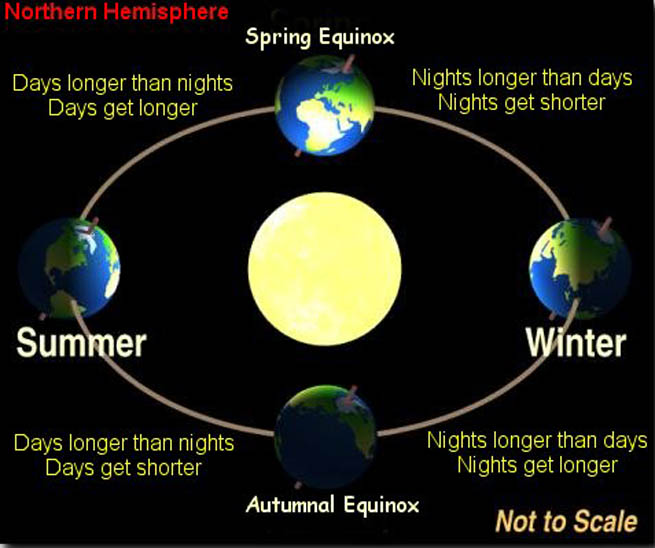
The converse of all of this is that as the days get longer, the nights get shorter and vice versa. At some stage the length of the night is equal to the length of the day. But only in passing.
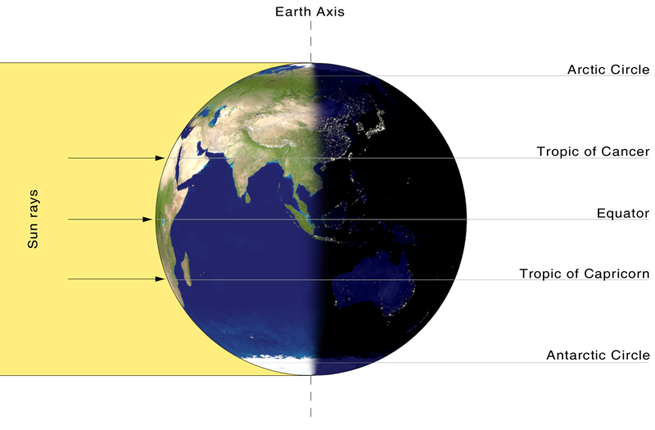
The word equinox derives from the Latin meaning ‘equal night’ (the ‘equi’ part is fairly easy to work out and if you link ‘nocturnal’ to ‘nox’, you are unlikely to forget this either). It is so named because around the time of the equinox the length of the day is around the same length as the night.
You also probably remember, from school or elsewhere, that the lengthening or shortening days (and the seasons) are due to the Earth’s axis being tilted.
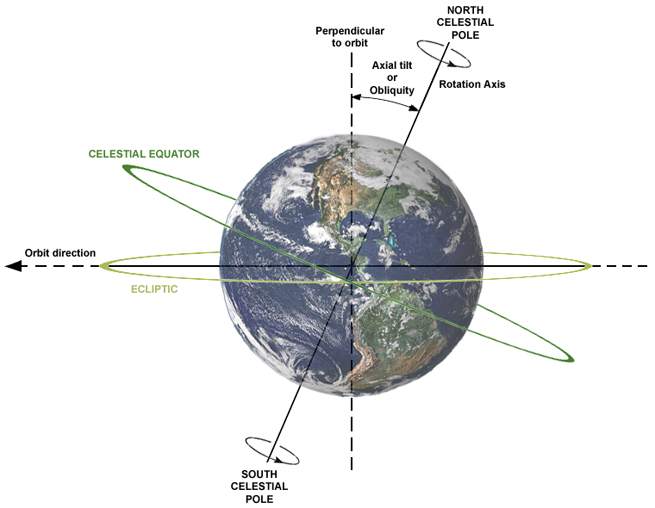
The equinox itself happens when the Earth’s axis is tilted neither toward nor away from the Sun. Another way of putting this is that the equator is in the same plane as that in which the Earth orbits (the ecliptic).
Picture a disc centred on the Sun, around the edge of which we orbit. Picture also a disc through the centre of the Earth, cutting it at the equator. When these two discs coincide we have an equinox.
Imagining these two discs also helps you picture that standing on the equator near the time of the equinox means that the Sun rises in the east, is pretty much directly overhead at noon* and sets in the west.
*Local noon is defined as the time at which the Sun is at its highest point above the horizon.
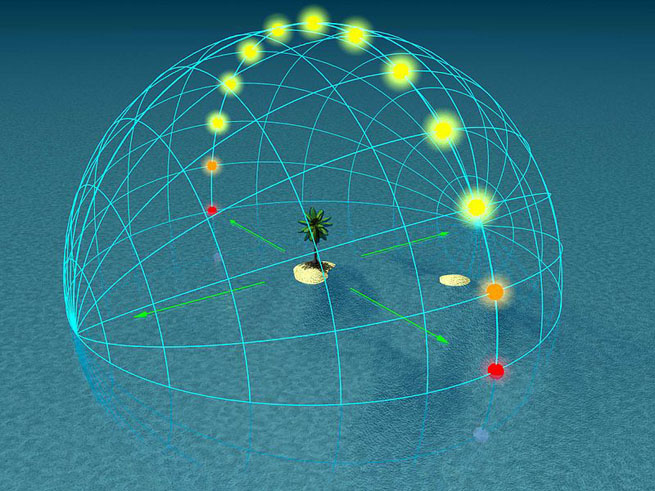
As you travel north on the day of an equinox, the Sun will be a little lower in the sky at noon (to the south) and as you travel south the Sun will be a little lower in the sky at noon (to the north).
On the day of an equinox, wherever you stand – on the equator, or north or south of it, the Sun will rise directly east and set directly west.
Now if you think about it harder, if the Sun is only overhead at noon on the equator at particular points in time, it must be overhead at noon at other neighbouring latitudes on neighbouring days. There is a limit to how far north or south you can go and ever have the Sun overhead at noon – these limits are the Tropics of Cancer and the Tropic of Capricorn. The latitude of these circles (23.4378 degrees north and south respectively) correspond to the tilt of the Earth’s axis away from the plane on which it orbits. The area between them describes a zone where the Sun reaches a point directly overhead at least once per year. This area is known as the Tropics.
North of the Tropic of Cancer, the Sun will always be south of directly overhead, even at noon. South of the Tropic of Capricorn, the Sun will always be north of directly overhead, even at noon.
On the days of the equinox, wherever you are, the height of the Sun at noon will be equal to 90 degrees minus your latitude. So, if you are on the equator, the Sun will be overhead at noon (as discussed above). If you are at one of the poles, the Sun will be on the horizon at noon.
If you are in London (51.6 degrees north), the Sun will be approximately 90 – 51.6 = 38.4 degrees above the horizon at noon. This is only approximate because unless the actual time when the axial tilt is zero relative to the Sun coincides with the local noon in London, the height of the Sun at noon will be a little more or a little less than this.
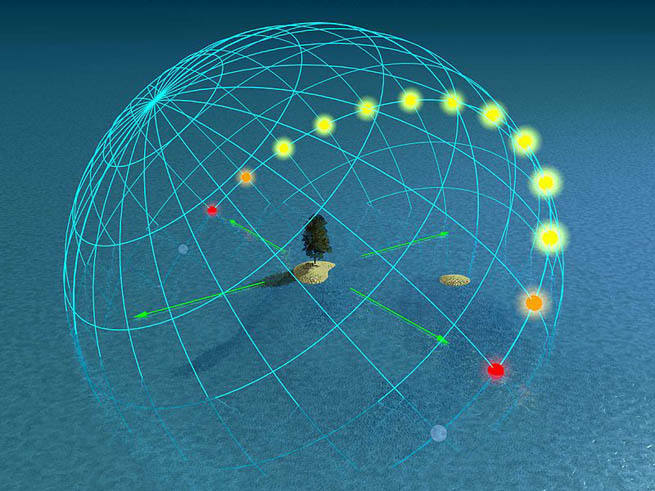
For example, in 2012, the March equinox actually occurs at 05:14 GMT on March 20th; so by noon, the Sun will be a little higher than our approximate calculation above. Checking the US Naval Observatory website shows that the Sun will be 38.6 degrees above the horizon at local noon (12:06 GMT) in London on this date.
The height of the Sun at noon is not safe to check with the naked eye but you can certainly get your compass out and check sunrise and sunset bearings, particularly when the sun is just below the horizon. In the UK at the moment you won’t have to adjust for the difference between magnetic north and true north but in other parts of the world you might.

If you are reading this near to the time of an equinox, please leave a comment below with where you are in the world, and the compass bearing (in degrees) you obtain for sunrise or sunset, or both.
Latest posts by Paul Kirtley (see all)
- The Swedish Firesteel - January 5, 2023
- Kevin Callan and Paul Kirtley in Conversation - April 25, 2020
- Kevin Callan and Ray Goodwin in Conversation - April 18, 2020

hedgey
Out of this world, this is fantastic Paul. I was watching this on TV the other night, the show with Kate Humble in it, I was trying to understand what go’s on, now i know, thanks Paul, great stuff again, it just keeps coming.
Keep the faith
Hedgey
Paul Kirtley
Hi Hedgey
Pleased you found it illuminating (pun intended 🙂 ).
I have to say I didn’t see the Kate Humble programme.
I’m glad this was able to help your understanding though and thanks for the feedback…
All the best,
Paul.
Dave Dean
Yeah I saw the Kate Humble thing too. This is a much clearer explanation though!
Paul Kirtley
Hi Dave, thanks for the feedback.
All the best,
Paul
Mark H
Superb explanation – I’ve been looking up at the skies alot more of late ! Thank you for your time and effort,
Best
Mark
Paul Kirtley
Hi Mark,
I’ve had a fascination with the solar system since I was at primary school – I remember filling up an exercise book with notes, diagrams and pictures, much to my teacher’s amazement.
Having studied Maths, I find I can understand the mechanics of the movements of the celestial bodies fairly easily. But what I do find is that some areas are often not explained in a way that is accessible to most people and any whiff of Mathematics scares a lot of people away.
What’s brilliant for me as a bushcraft instructor is relating this knowledge to practical uses and observations in the field. Encouraging people to step outside, try something or make an observation at a particular time and them saying “hey that works!” or “yep, I can see that too!” makes me smile 🙂
More profoundly, it seems to help people re-connect with the natural world in a large-scale way that would have come more naturally when all we had above us most of the time was the sky…
Thanks for your comment.
Best,
Paul
Paul Moseley
Lovely article again Paul, we teach a lot of this field on our coastal courses, Beach Schools, regarding the relative positions of the earth, moon and sun through out the year. It can give someone a very down to earth existential awareness, at the very least it is eye opening.
Paul Kirtley
Hi Paul
Thanks for your comment, it’s nice to hear from you.
It’s great that you are introducing youngsters to these concepts. It’s an awareness that’s likely to remain with them throughout their lives.
All the best,
Paul
Pär
Location: E 14deg 22 min, N62deg 02min
1811 local time, sun just below the horizon, azimut 271deg
http://aa.usno.navy.mil claims that at 18:10 the sun is at 270.4 (and 0.9 deg over the horizon, but the Navy don’t care about forests…)
Aptitude Design
cosine diurnal arc = -tan latitude tan declination: double divide by 15 for hours of daylight
cosine azimuth = sine declination secant latitude
Paul Kirtley
Very helpful.
Lalit
Hi Paul,
Great explanation about the solstice and equinox. Now l
better understand the Sun and the Earth. Keep shining
Like the Sun and enlighten us.
Regards,
Lalit
Paul Kirtley
Hi Lalit, glad you liked this article 😉
Warm regards,
Paul
Austin Lill
Hi Paul,
I touched on this at Cubs the other week. A got one Cub to be the Earth and and covered the seasons and so on as he went around the rest of them pretending to be the sun. Not sure they fully believed when I said that the Sun doesn’t rise and set in the East and West most of the time to be honest.